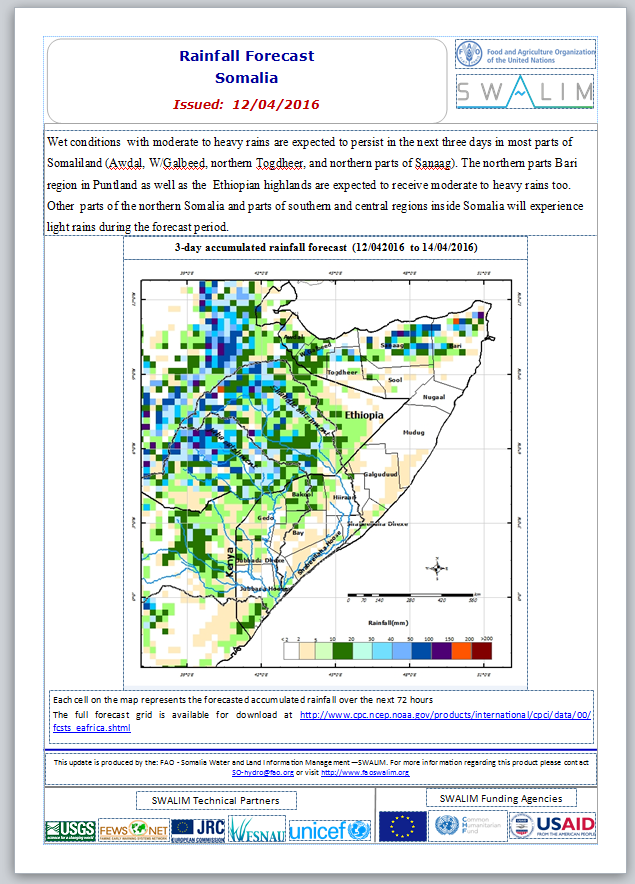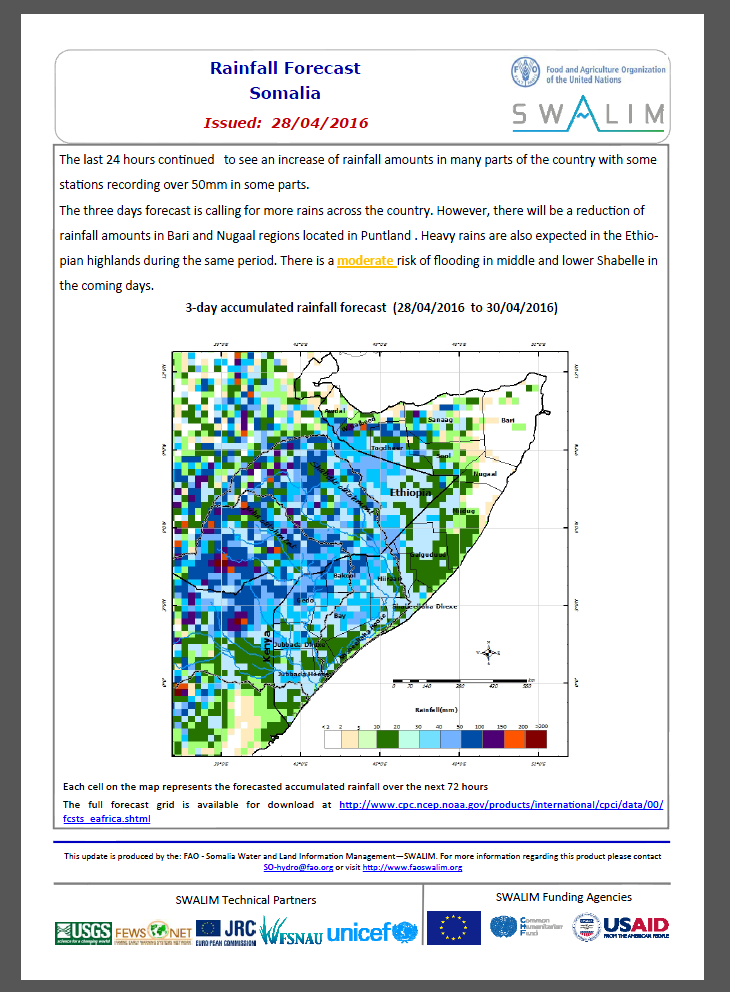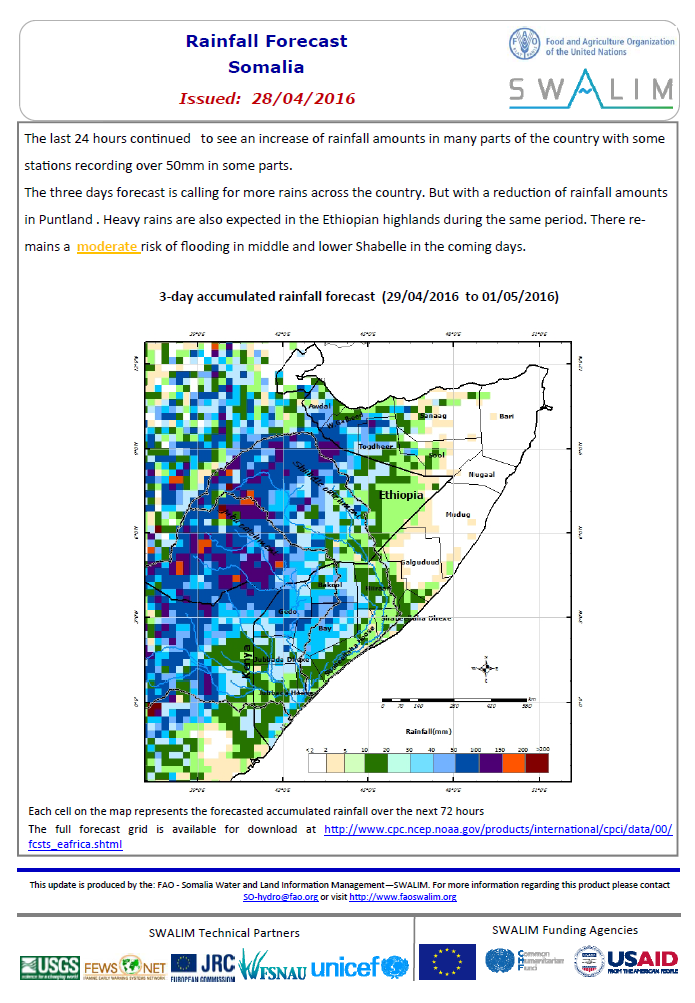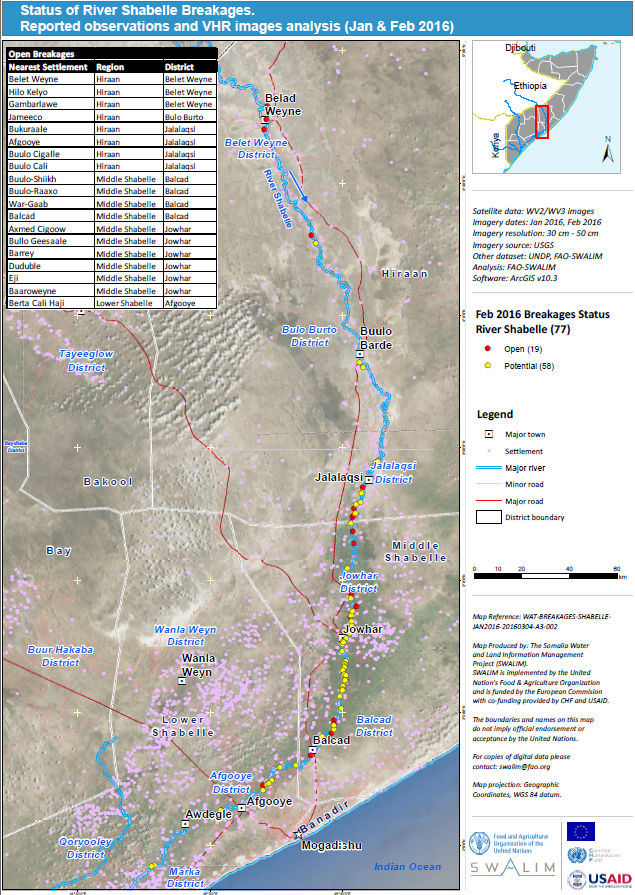Library Catalog
Latest Documents and Publications listed. Use search terms in the box below to find what you need
Somalia Rainfall Forecast 13-04-2016
Wet conditions with moderate to heavy rains are expected to persist in the next three days in most parts of Somaliland (Awdal, W/Galbeed, northern Togdheer, and northern parts of Sanaag). The northern parts Bari region in Puntland as well as the Ethiopian highlands are expected to receive moderate to heavy rains too. Other parts of the northern Somalia (Nuugal and southern Bari) and parts of southern and central regions inside Somalia will experience little or no rains during the forecast period.
Publication Type:
Rainfall Forecast
Publication Date:
Author:
Corporate Author:
Somalia Rainfall Forecast 12-04-2016
Wet conditions with moderate to heavy rains are expected to persist in the next three days in most parts of Somaliland (Awdal, W/Galbeed, northern Togdheer, and northern parts of Sanaag). The northern parts Bari region in Puntland as well as the Ethiopian highlands are expected to receive moderate to heavy rains too. Other parts of the northern Somalia and parts of southern and central regions inside Somalia will experience light rains during the forecast period.
Publication Type:
Rainfall Forecast
Publication Date:
Author:
Corporate Author:
Somalia Rainfall Forecast 28-04-2016
The last 24 hours continued to see an increase of rainfall amounts in many parts of the country with some stations recording over 50mm in some parts. The three days forecast is calling for more rains across the country. However, there will be a reduction of rainfall amounts in Bari and Nugaal regions located in Puntland . Heavy rains are also expected in the Ethiopian highlands during the same period. There is a moderate risk of flooding in middle and lower Shabelle in the coming days.
Publication Type:
Rainfall Forecast
Publication Date:
Author:
Corporate Author:
Somalia Rainfall Forecast 20-04-2016
The three days rainfall forecast is calling for a reduction of rainfall activities in many areas. Light rains may be experienced in western Somaliland and southern regions The upper parts of the Ethiopian highlands are expected to get moderate rains. Dry conditions are expected in the other parts of the country.
Publication Type:
Rainfall Forecast
Publication Date:
Author:
Corporate Author:
Somalia Rainfall Forecast 29-04-2016
The last 24 hours continued to see an increase of rainfall amounts in many parts of the country with some stations recording over 50mm in some parts. The three days forecast is calling for more rains across the country. But with a reduction of rainfall amounts in Puntland . Heavy rains are also expected in the Ethiopian highlands during the same period. There remains a moderate risk of flooding in middle and lower Shabelle in the coming days.
Publication Type:
Rainfall Forecast
Publication Date:
Author:
Corporate Author:
Somalia Rainfall Forecast 08-04-2016
The wet conditions with moderate to heavy rains are expected to persist in the next three days in most parts of Somaliland and Puntland and the Ethiopian highlands. Other and parts of southern central regions are expected to record light too moderate rains withn the same period.
Publication Type:
Rainfall Forecast
Publication Date:
Author:
Corporate Author:
Somalia Rainfall Forecast 25-04-2016
The three days rainfall forecast is calling for an increase of rainfall activities in many areas of the country. Heavy rains of between 40mm to 150mm will be experienced in the Ethiopian highlands while most parts of Somalia may get up to 50mm within the three days.
Publication Type:
Rainfall Forecast
Publication Date:
Author:
Corporate Author:
Somalia Rainfall Forecast 14-04-2016
Most parts of Somaliland, northern parts Bari region in Puntland as well as the Ethiopian highlands will continue to receive rains in the next three days. Other parts of the northern Somalia (Nuugal and southern Bari) and parts of southern and central regions inside Somalia will experience little or no rains during the forecast period.
Publication Type:
Rainfall Forecast
Publication Date:
Author:
Corporate Author:
Somalia Rainfall Forecast 30-04-2016
The last 24 hours have seen heavy rains within the Juba and Shabelle basins both in Ethiopia and Somalia. This has led to a drastic increase of river levels along the two rivers. Today the river level at Luuq along Juba is 6.10m which above the high risk of flooding. River flooding have reported in Luuq area and the surrounding.
The three days rainfall forecast is calling for more rains in the basins. Given the rainfall forecast and the rising levels there is a high risk of flooding along the Juba River as well as the Middle and Lower reaches of Shabelle River in the coming days.
Publication Type:
Rainfall Forecast
Publication Date:
Author:
Corporate Author:
Status of River Breakages Along Juba and Shabelle Rivers as at Feb 2016
The Gu 2016 (March to May) rainfall forecast points towards enhanced rainfall activities within the Shabelle river basins in Somalia and the Ethiopian highlands. Consequently, open river bank points and poor river embankments are likely to cause flooding in the event of heavy rains and increased river flow.
SWALIM has updated the status of the river breakages by mapping them using very high resolution satellite imagery for the period 2015 and 2016 and a Digital Elevation Model (DEM) and verifications with field observations.
Three types of breakages have been identified namely; open, potential and closed. The open breakages are those that are still open during the months of January and February 2016. The potential breakages represent points that have very weak river embankment or have experienced several breakages in the recent past and minimal or no interventions have been put in place. The closed breakages are those that were previously open but efforts have been made to close them.
The attached and maps and tables provide the open and potential river breakages along the two rivers. In summary, 19 open points along the Shabelle and 23 along the Juba have been identified. Several other points with potential of breaking have been identified and need to be strengthened immediately.
It is however worth noting that the methodology heavily relied on satellite imageries and field verification with limitation of physical access at some locations. Open breakages might have been omitted in some cases where satellite images may not have been very clear or not available at all.
Maps of the status of river breakages with detailed information have been produced at large scale and hard copies can be obtained from SWALIM offices.
Publication Type:
Map
Publication Date:
Author:
Corporate Author:
Pages
 RSS feed [compliant with the Agris AP] |
RSS feed [compliant with the Agris AP] |  Agris AP XML
Agris AP XML







